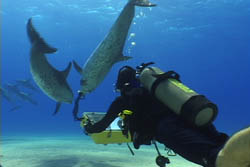
BabyBoomOrca
The birth of the fifth killer whale calf this year within the endangered southern resident killer whales pods is spectacular news. The births bring the total number of animals in J, K and L pods to 87.
"It's a baby boom," said Howard Garrett of Orca Network. http://www.orcanetwork.org
But this news is countered by the fact that seven orca of these same groups died over the past winter. There is genuine concern about the survival of these highly beloved whales. The salmon on which these orca feed has been in low supply and the whales that died showed signs of emaciation. They are also some of the most toxic animals on earth, containing huge levels of chemicals such as PCBs.
Historically, the three pods had about 120 members. But that was before dozens of these magnificent animals were cruelly captured for the aquarium trade. In the late 1990s dredging in Puget Sound may have released plumes of toxic sediments that poisoned the animals downstream of the location.
Dr. Ken Balcomb, of the Center for Whale Research, a longtime friend, was one of the researchers who first photographed the newest arrival. I’ve spent joyous times with Ken running with the J, K and L pods. In my film “The Dolphin Defender” Ken describes the crisis these orca face from lack of food and pollution.
The newborn calf has characteristic pink markings and folds behind the dorsal fin. The calf was swimming with Polaris, its mother, a 16-year-old aka J28. See video http://www.youtube.com/watch?v=cIAT-DnD2ek
In my days with Ken he described how female orca offload lipophilic (fat binding) toxic chemicals into their newborns through their lipid rich milk. This reduces the mother’s toxic burden but has always struck me as among the most perverse results of how we treat the oceans as a dump for deadly chemicals. The new arrival will have a better chance of survival because its mother has already had a calf that died. Its death would have allowed Polaris to eliminate toxins such as PCBs and fire retardants from her system, according to Balcomb.
Another source of hope is that this year
has been much better for salmon than last. "I just hope they are well-fed from the summer and don't have to dig too far into their fat reserves. We'll do a roll call when they all come back at the
beginning of next season," Balcomb added.
More information on contaminants in the marine environment dangerous to both killer whales at humans at http://www.bouevoice.org


No comments:
Post a Comment